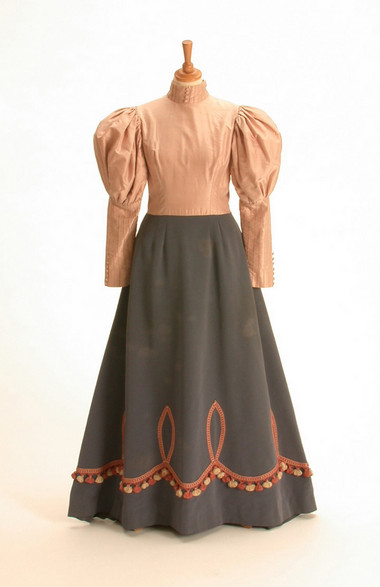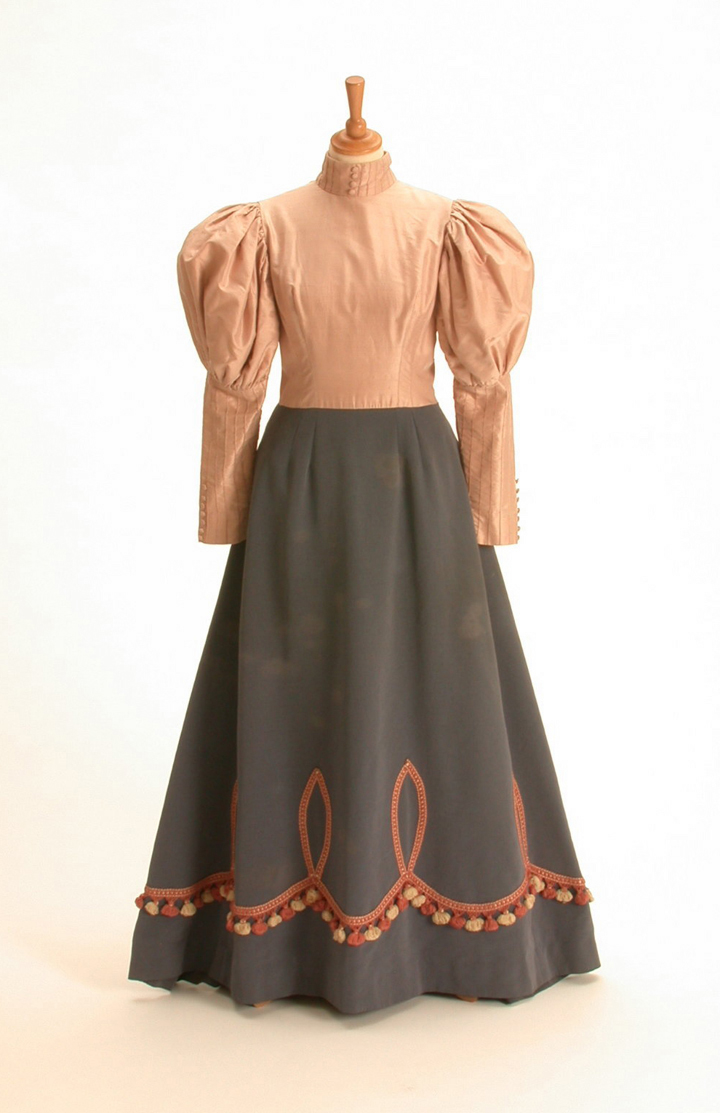Leg-of-Mutton Sleeve Dress, Victorian, Replica
The very distinctive sleeves of this dress are called leg-of-mutton because that is exactly what they looked like - legs of mutton. (A leg of mutton is very wide at one end and narrow at the other.) The sleeves on this dress are very tight from the wrist to the elbow and then very large from the elbow to the shoulder. The effect of volume was achieved by stitching gathers into the fabric, and putting stiff fabric on the inside to make the sleeve stand out.
Leg-of-mutton sleeves came into fashion at the end of the 19th century and were still being worn at the beginning of the 20th century. During this period it became common for women to wear separate blouses and skirts that actually looked separate. This item of clothing is the other way round - it looks like a skirt and bodice but it is a dress.
As well as being decorated around the hem of the skirt, this dress has other clever details, such as tiny tucks in the bottom part of the sleeves and round the neck and rows of little covered buttons, again at the wrists, and at the neck.
Leg-of-mutton sleeves came into fashion at the end of the 19th century and were still being worn at the beginning of the 20th century. During this period it became common for women to wear separate blouses and skirts that actually looked separate. This item of clothing is the other way round - it looks like a skirt and bodice but it is a dress.
As well as being decorated around the hem of the skirt, this dress has other clever details, such as tiny tucks in the bottom part of the sleeves and round the neck and rows of little covered buttons, again at the wrists, and at the neck.



The very distinctive sleeves of this dress are called leg-of-mutton because that is exactly what they looked like - legs of mutton. (A leg of mutton is very wide at one end and narrow at the other.) The sleeves on this dress are very tight from the wrist to the elbow and then very large from the elbow to the shoulder. The effect of volume was achieved by stitching gathers into the fabric, and putting stiff fabric on the inside to make the sleeve stand out.
Leg-of-mutton sleeves came into fashion at the end of the 19th century and were still being worn at the beginning of the 20th century. During this period it became common for women to wear separate blouses and skirts that actually looked separate. This item of clothing is the other way round - it looks like a skirt and bodice but it is a dress.
As well as being decorated around the hem of the skirt, this dress has other clever details, such as tiny tucks in the bottom part of the sleeves and round the neck and rows of little covered buttons, again at the wrists, and at the neck.
Leg-of-mutton sleeves came into fashion at the end of the 19th century and were still being worn at the beginning of the 20th century. During this period it became common for women to wear separate blouses and skirts that actually looked separate. This item of clothing is the other way round - it looks like a skirt and bodice but it is a dress.
As well as being decorated around the hem of the skirt, this dress has other clever details, such as tiny tucks in the bottom part of the sleeves and round the neck and rows of little covered buttons, again at the wrists, and at the neck.




















